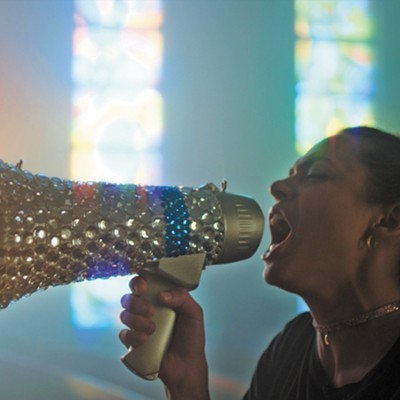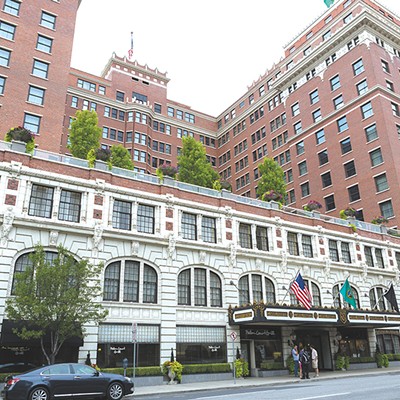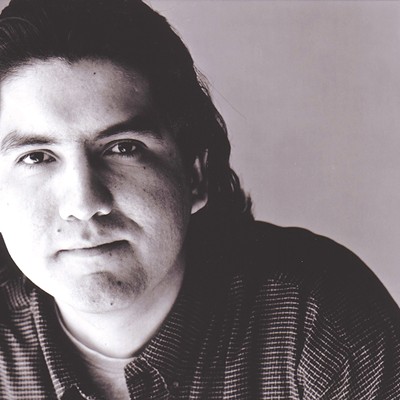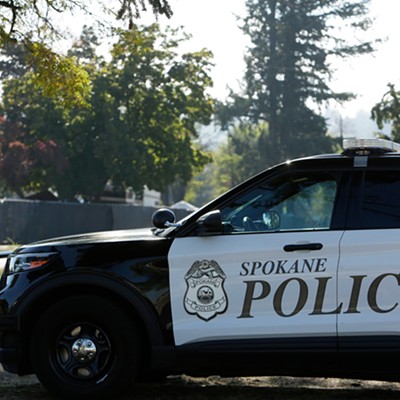93
For our first cover story (10/20), with the Spokane housing market booming, we wrote about growth. Planners were freaking out that a fix for Western Washington — the Growth Management Act — was being imposed on Spokane. "We're busting at the seams," John Mercer, the GMA coordinator for Spokane County told us.
Also in that first issue, we covered a cool new district called Carnegie Square, a hip new shop by the name of Boo Radley's and even reviewed Pearl Jam's latest record, VS.
We described the tough spot Tom Foley was finding himself in back in D.C. (11/10), torn between his own political goals and the goals of the president, Bill Clinton. Obviously, this problem would get worse for him, culminating with his ouster — the only Speaker of the House tossed in, like, forever.
We devoted a cover to possibly the worst local theater production in history (11/17). Audacious Sandpoint musician Scott Haynes rented the Opera House, wrote, scored and unleashed Atlantis on the Inland Northwest. We gave Haynes a cassette recorder to document his process leading up to the premiere. "I couldn't imagine that people wouldn't just jump onto this thing, because in my mind it's just an awesome show," Haynes said. "But ... Conveying it to someone else is a different story."
Downtown booster Karen Valvano's dream for a Davenport Arts District merited a cover story (12/1). "It will give all of us somewhere fun to go, a renewed interest in downtown and a feeling of pride," Arts Commissioner Sue Ellen Heflin told us about rehabbing the neighborhood of the then-shuttered Davenport Hotel.
Three Men and a Sandwich debuted (12/15), with Jer McGregor, Jim Cortner and Andrew Strickman testing the Elk and a joint called Hans and Marianne's Backerei and Kaffee Stube.
"So how do closet oenophiles go about educating themselves?" our Nick Heil asked (12/29). "Why, at the source, of course." We pointed readers to a small-but-growing business sector — winemaking. Then only practiced by eight local wineries, we shared the apparently obscure fact that you could visit them and, you know, taste their stuff. — TED S. McGREGOR JR.
Featured story: New Kid in Town
94
"Follow the Microchip Road" (2/2) marked the first of many stories we would write alerting the Inland Northwest to the growing popularity of something called the Internet. We seemed to nail it when we wrote, "The Tablet will be a consumer appliance as easy to use as your microwave oven."
The late, great Gonzaga Coach Dan Fitzgerald crowed about his home-court advantage (2/9), saying "Anybody who doesn't like the Kennel Club can get Symphony tickets." Still makes sense.
We published our first Healthy Living issue (3/2), which continues under the Inlander brand in the evolved form of the glossy InHealth magazine.
The concept of a readers poll debuted in Eastern Washington in the form of our Best of the Inland Northwest issue (4/6). It marks the only time Tom Sherry has ever lost in the Best Weathercaster category. (KXLY's Steve Mumm was the fave.) Some things never change, though, as readers voted the North-South Freeway as the Best Thing the Inland Northwest Doesn't Have Yet.
In "The Perot of North Idaho," we profiled the late rabble-rouser Ron Rankin (4/13), who was changing the political landscape of Coeur d'Alene — and Boise. "I think it is ridiculous to let someone like Ron Rankin set the state agenda," then-State Sen. Mary Lou Reed (and current Inlander columnist) told us.
Robert Herold joined the team; his first column (4/20) criticized the city for not paying enough attention to the most local of concerns: "Neighborhood groups must be invited to participate," he wrote.
In the first of many stories on the topic, we dug into the chances the Davenport Hotel could be reopened (12/7), as a visiting urban expert had recently advised. With an oil spill discovered in the vicinity, it wasn't looking good.
At the peak of their popularity, Coeur d'Alene's eight-piece funk-rock band, Black Happy, called it quits (12/14). "We all want to do some new things," guitarist Paul Hemenway told us, "so it's time to move on." One of their last local gigs was New Year's at Playfair. The group reunited for a short tour of Spokane and Seattle in 2010. — TED S. McGREGOR JR.
Featured story: Capital Punishment
95
In "The Building Behind the Big Fuss" (2/1), we described the Spokane Transit Authority's controversial plan to build a $20 million bus station in the middle of downtown. "In the end," STA Executive Director Robert Allen Schweim told us, "it will have been worth every penny."
The microbrew revolution is nothing new around here; we detailed the growing industry in our "Microbrew Mania" cover story (2/15). The names have changed, however, as the breweries we featured included Hale's Ales, Fort Spokane, T.W. Fisher's and the Birkebeiner.
Post Falls was sprawling so fast, we took a closer look with "Growing Pains" (3/15). "As Californians and Easterners arrive en masse, the landscape is changing," we wrote. "Bluegrass fields become strip malls. Luxurious homes sprout up around lakes where trees once stood. Suddenly there's a rush hour."
We profiled local author Sherman Alexie on the occasion of his Reservation Blues being published (4/26). At 29, with a profile in Esquire and awards rolling in, he told us, "I think I've outlasted any flavor of the day ... at least I hope so."
We devoted our cover story to legendary local artist Harold Balazs in "An Artist for All Seasons" (5/31). From his days selling his jewelry at Joel, he talked about how he landed a couple commissions to make metalwork — which, he says, he could "sort of fake" as his father ran a sheet metal business. "I'm a veteran eclectic," Balazs concluded.
The notoriously dated Boone Street Barn was no more, replaced by the new Spokane Arena. In "Arena of Dreams" (9/6), we wrote, "Those with weak bladders can rejoice; there will be 257 toilet fixtures to supplant the needs of those who consume the 4,288 gallons of beer products that will be available..."
Local journalist Jess Walter was getting strong notices for his new book Every Knee Shall Bow, which detailed the Ruby Ridge standoff. In "Author Under Seige" (11/8), we asked him about his new-found fame. "It's been pretty heartwarming to see how quickly I could fade back into obscurity," he told us. Sorry, Jess, but obscurity just wasn't in the cards. — TED S. McGREGOR JR.
Featured story: Welcome to Loserville
96
Things were changing in 1996, and this newspaper did a lot of wondering what was next. Nothing signaled this more than a cover story (2/14) investigating the notion that perhaps this whole world wide information super Internet highway web was everything it was cracked up to be. The story pointed out that twice as many Americans bought the latest Hootie and the Blowfish album as were using the Internet. Sources in the piece wrongly predicted that people wouldn't flock to the web to buy things, yet correctly foresaw the future of online pornography.
Locally, the paper was diving headfirst into the sort of topics that some might prefer to sweep under the rug. The Inlander contemplated serious issues in its pages, among them suburban sprawl (9/25), poverty (5/15) and racism (1/17), and penned several stories about teens and how the community had used them as scapegoats for some of the city's woes. Sound familiar?
We profiled longtime Gonzaga University President Bernard Coughlin, S.J. (5/22) as he stepped down after 22 years, and wrote about the school's head basketball coach Dan Fitzgerald (11/20), who was entering his final season, having paved the way for a program that was about to explode onto the national stage.
We continually asked if River Park Square would ever become anything other than architectural drawings (11/27), then wondered if the world was coming to an end when Ice Storm gave the region a mighty slap, leaving some without power for more than a week (11/27).
On the cultural front, the tide of the early 1990s Seattle rock explosion led Spokane music lovers to wonder if perhaps big-time success could come to one of their beloved local bands. Several music stories excitedly speculated that major labels might be looking to sign bands like Shoveljerk (a variation of the by-then-defunct Black Happy) and High Lonesome. At the same time, a column proposed the question Is live music dead?, mourning the loss of the Big Dipper and other rock venues.
Our political coverage was prescient, too, as it turns out. The fall election preview (9/11) introduced us to a long-shot gubernatorial candidate named Jay Inslee, while the 20 Under 40 section (3/13) profiled a young guy named Andy Billig, who was working for the Spokane Indians.
You can't predict the future, but damned if we didn't try back in 1996. — MIKE BOOKEY
Featured story: Faces of Fitz
97
The Inlander charged along in 1997, as did the Inland Northwest. Downtown Spokane (5/14) development was beginning to pick up, the Lincoln Street Bridge debate surged, and all the while we had to worry about the impending arrival of El Nino (10/15), which a cover exposé warned would be the weather event of the century.
For whatever reason, '97 featured no shortage of weirdness in our pages. There's a glowing profile of Timothy Treadwell (3/26), who spent his summer living with grizzly bears in Alaska. Those bears killed him six years later. Herpes must have been rampant, judging from a three-page ad for Valtrex (4/30), as were fad diets, which is why we outlined the dangers of Fen-Phen (9/17). Hell, things were weird enough that Carrot Top earned himself a multi-page profile (9/10).
Our Fall Arts Preview (9/19) clocked in at 60 pages — massive in those days — and looked into the state of arts in Spokane at that time, especially the struggles to fund galleries and theaters.
On the political front, medical marijuana made its first appearance in the paper (10/15) as we talked to both sides involved in a debate that would rage until the initiative was voted into law a year later. Then there was the statewide battle over a new proposed stadium for the Seattle Seahawks (3/26), which would have a financial impact on this side of the mountains, as we detailed in a cover story. Eight years later, the Seahawks won the NFC championship in that eventually realized stadium.
In other sports news, of which there was plenty in '97, our Bloomsday preview featured race tips by Bloomsday Boy (4/30), a reckless race participant who encouraged runners to, among other things, do the Macarena — remember the Macarena? — as often as possible. We ran a small piece about a scrappy Gonzaga basketball team that had just beaten No. 5 Clemson, then devoted an entire cover package to WSU going to the Rose Bowl (12/24) for the first time in 67 years behind the powerful arm of then-quarterback, now-recovering drug addict Ryan Leaf. The Cougs lost that one to Michigan. — MIKE BOOKEY
Featured story: Pickett's Charge... Again?
98
Beanie Babies, Y2K and vampires all made the cover of the Inlander in our fifth year of publication. A special investigative report in March, called "Burned" (3/4), explored how the Spokane Waste-to-Energy Plant imported garbage from Canada and incinerated questionable substances without proper safeguards.
As Spokane serial killer Robert Lee Yates still stalked the streets, not yet identified or imprisoned in April of '98, the Inlander focused on how investigators had tracked other killers and the psychology behind their horrendous crimes. "It's a screwed-up society that produces serial killers," true crime author Jack Olsen says, adding, "In a society that's spinning faster and faster and faster, every once in a while somebody spins off the edge."
We started the Y2K fretting early with "Day of Reckoning" (7/15) on the potential impact of the Millennium Bug. In that same issue, we took on the Aryan Nation's plans to march in Coeur d'Alene, and the community debate over whether to counter-protest or simply ignore such white power marches.
In "Pill Popper Nation" (7/22), the Inlander dove into the country's increased dependence on and marketing of prescription drugs. We also looked at what the introduction of Viagra might mean for pharmaceutical profits.
By October, the Inlander reached its fifth birthday (10/14). Looking back, publisher Ted McGregor wrote about the rise of alternative weeklies: "I attribute this popularity to trust. People can distinguish between being fed a line and being told the truth."
For our Halloween issue (10/28), the Inlander explored vampires and the scary world of Congressional elections. "There's the sexuality and the seductiveness. That it's attractive is just part of human nature." We'll let you guess which subject that quote applied to.
Our 1998 coverage wrapped up with the transition from Washington Water Power to Avista as the local utility looked to expand (12/16). "We need to do whatever it takes to be successful," utility vice president Rob Fukai said. "If you don't in this industry, then you're going to disappear." — JACOB JONES
Featured story: The Double Life of Billy Tipton
99
Partying like it was 1999 seems to have involved a lot of strong mayor city government, River Park Square squabbles and more Y2K jokes. The Inlander started the year with an analysis of the region's home building rates, asking if construction had outpaced growth (1/20).
We profiled Gonzaga basketball coach Dan Monson in "Coaching Karma" (2/24) as the Bulldogs made their historic run to the Elite Eight in the NCAA tournament. They ended the season with a 28-7 record.
In April (4/14), the Inlander wrote about both abstinence-based sex education and the dangers of the professional bull-riding circuit. "[It's] not a safe sport, not by any stretch of the imagination. If you want something safe, you can play golf." Again, we'll let you guess what story that quote goes with.
Downtown Spokane got an economic shot in the arm with the opening of River Park Square in August. In "Yes, We're Open" (8/18), we covered the last-minute construction work and talked to nearby retailers about their hopes for some new energy in downtown.
As longtime writer Nick Heil prepared to leave in September, he wrote about his love-hate relationship with Spokane. "I still don't know quite what it is that makes one place seem desirable to live," he writes. "My guess is ... at some point, it's the desire to simply stay put and make a place better. To recognize the potential of a place and to set about realizing it."
Local politics took over much of the fall. We covered the initiative vote to establish $30 vehicle tabs (9/1) and the move toward a "strong mayor" government. The strong mayor issue took over our cover in October (10/27) with a call for bolder leadership at City Hall.
The Inlander ended the year with helpful tips for the last New Year's Eve of the 1900s (12/1), offering suggestions on buying the right champagne, finding the best parties, and surviving a week without electricity. Just in case. — JACOB JONES
Featured story: People of the Century
00
The new millennium started off with a cover story (1/5) looking toward the year's big election and the prediction that 2000 would be the "Goliath of all money-in-politics years." We wrote about the popularity of Who Wants to Be a Millionaire? and praised Scream 3 as a "satisfying conclusion" to the trilogy. ("There will be no Scream 4," director Wes Craven said firmly.)
We turned a skeptical eye toward important issues of the day, such as e-medicine, e-dating, eBay, Napster, Palm Pilot etiquette, the Sacagawea dollar, Meg Ryan's hairdo and the ubiquitous Whasssuuup?!
But we were full of hope for "The New Internet," featured on the cover in July with a full explanation of how cable and DSL would totally change the way we surf (7/20). "Think of it: always connected, yet with your phone line free to accept vital incoming calls."
In March, a story called "Inside the Ballot Box" gave Spokane a crash course in the perils of hanging chads following the previous year's very close vote on the strong mayor system (3/1). "Few Spokane County voters realize that the outcome of an election hinges upon gnat-sized pieces of cardboard," the story began. Of course, that all changed by the end of the year when the presidential election between Al Gore and George W. Bush turned into a drawn-out Florida recount ultimately decided by the Supreme Court. Locally, former Congresswoman Maria Cantwell narrowly beat incumbent Slade Gorton to join Patty Murray in the Senate, and "political newcomer" John Powers was elected to Spokane's new top spot as strong mayor.
But the biggest local issue of the year turned out to be the River Park Square fight, with the public-private project deemed a "failure" just seven months after the mall opened. With parking garage revenue far below expectations, a story in February (2/17) detailed the flawed study, inflated estimates and rumblings about the city seeking ways to get out of the deal.
Meanwhile, NorthTown Mall built a new parking structure. The large ads boasted: "Now open with FREE PARKING..." — LISA WAANANEN
Featured story: Indelible Marks
01
For Spokane, change seemed like a positive thing in 2001. Sure, the country was still reeling from the bizarre 2000 election — one columnist complained that Aaron Sorkin's The West Wing was ruined now that George W. Bush was in office (2/22) — but Spokane was all about renewal and progress.
We devoted three covers to the impressive reopening of the restored Davenport Hotel and hope for the Fox Theater, and later featured the reopened MAC (11/29). We wrote brief-but-prescient stories about plans for South Perry District revitalization (2/15) and the rebirth of the Community Building as a hub for progressive nonprofits (1/18).
Jess Walter appeared on the cover (1/11) for his first novel, Over Tumbled Graves, and later we went on a downtown tour of cocktail revival with renowned mixologist Paul Harrington, now a co-owner of Clover. "Currently, I would rank Spokane as a city with above-average bars," he said after visits to Cavallino Lounge, Quinn's and Ankeny's at the top of the Ridpath (3/15).
We also took an honest look at tough problems, with cover stories about the meth epidemic (4/12) and the deadly effects of the asbestos mine (3/1) in Libby, Mont. We wrote a cover story about the ambivalence of being young in Spokane (8/30), and local musicians weighed in on why Spokane was having so much trouble supporting live music venues. We reported on the Spokesman-Review's reportedly first-ever newsroom layoffs (7/12). "It has never happened in the newsroom before," bargaining unit president Karen Dorn Steele said at the time. "We didn't even have a methodology in our contracts that said how this should be done."
The River Park Square revenue issue continued, with the city's bond rating taking a hit and bondholders heading to court. The year's back-and-forth culminated in a cover story styled after a very popular books series: "River Park Square Garage Litigation for Dummies" (12/13).
Of course, on the morning of Sept. 11, the world changed. We published an eight-page special issue on Sept. 15, a Saturday — the only time in Inlander history we distributed two issues in one week — with a story beginning on the cover headlined "The End of the Innocence," published here.
In the following months, life continued with movie reviews and holiday season guides, but with an undercurrent of uncertainty about what to expect from the new year. — LISA WAANANEN
Featured story: The End of the Innocence
02
With our nation at war, we collected a series of essays under the heading "HAVE WE WON YET?" (1/24). The question would be answered resoundingly over the next decade.
We hyped up the Sega Dreamcast in our video game column (1/24) and, in the same issue, covered ska sensation 10 Minutes Down's odd choice to open for heavy metal band Blue Oyster Cult.
In our Is Spokane Bad for You? cover story, we fretted about the region's apparently high rate of multiple sclerosis (1/31). Nine years later, we questioned those claims with a story titled, "Misdiagnosed: Why Spokane's infamously high MS rates may be nothing more than a self-fulfilling myth."
We looked at how century-old wounds from forced relocation continued to affect the Nez Perce tribe (9/5) in Idaho. And as the Internet began increasingly affecting the everyday lives of Spokanites, we examined the growth of identity theft with a cover story called The Name Game (8/3) ( "It's not murder, but identity theft can be just as scary.") Later, we looked at the risky world of online dating (5/30), where an online relationship between an underage Eastern Washington girl and an older man ended in marriage for them — and a sex offender label for him.
It was a year of theatrical censorship. First Gonzaga wouldn't allow the Vagina Monologues to be performed on campus (2/21). Next, The Laramie Project, about the murder of gay college student Matthew Shepard got a little too controversial for Lewis and Clark School. The principal worried that a play about the dangers of homophobia used the word "faggot" too much and canceled the performance (8/10).
In May, residents of Spokane Valley voted to officially become the City of Spokane Valley (5/9). "They look like a city, they act like a city, they just need to draw a line around it and become a city," said Dennis Scott, campaign director for the incorporation effort. Years of debate over what Spokane Valley could do to seem more like a city followed. And in the city of Spokane, the grand Davenport Hotel opened (7/10), even as the other major force of downtown revitalization, River Park Square, continued to be swamped in litigation (8/8). — DANIEL WALTERS
Featured story: Reading the Region
03
A decade before Obamacare launched, the Inlander hammered away at the health care system, investigating the cost of medical malpractice lawsuits (4/10), expensive hospital expansions (5/29), the sprawling number of uninsured in Washington state (11/6) and the tangled bureaucracy that made navigating the medical system a nightmare (5/15).
We were ahead of the times in another way as well: A book review of infectious greed (5/8) got all paranoid about the dangers of "interest rate swaps, collateralized mortgage obligations, derivatives of every shape and color" and predicted that economic busts like the dot-com bubble were "part of a larger story of out-of-control speculation that has yet to reach its final chapter."
A retrospective on Spokane's century-old campaign to fight prostitution and vice (7/10) marked one of those rare times we put a completely naked woman on our cover, naughty bits covered by red "1910" text. Like this year, we examined GMOs (7/17) but with a lot more good old-fashioned scaremongering — the cover featured a syringe of green liquid injected into a tomato and teased: "There's a giant experiment underway on creating genetically modified foods and — surprise! — you're the guinea pig."
We covered a five-way mayoral race (8/14) that included hapless incumbent John Powers, local newsman Tom Grant and future scandal-maker Jim West, as well as a proposal to do away with the strong mayor system entirely.
In a world racked by war, our Ann Colford visited a place to get away from it all (3/20), just south of Lewiston in Cottonwood, Idaho — the St. Gertrude's Monastery, where Benedictine sisters have been welcoming pilgrims since 1907.
As the year closed, a piece called The Two Towers (12/18) surveyed the war between the forces of the Cowles family, owners of the Spokesman-Review and River Park Square, and the forces led by the wealthy Sandifur family, represented by the Metropolitan Mortgage building. In that same issue, our theater critic explored the crisis of low-ticket sales, financial woes, and board turnover at the Interplayers Theatre. John Deen, board president at the time, gave a quote that could just as well apply to Spokane's theater crises this year: "And as for the personalities, well, let's just say, you know theater people — they tend to be a little dramatic." — DANIEL WALTERS
Featured story: River Scenes
04
Nationwide, 2004 was a year of Iraq War skepticism and presidential campaigning, and that was no different in Spokane. We covered the early ramifications of the war and the race between George W. Bush and John Kerry. We dove into the existence (or not) of weapons of mass destruction (2/12) and pondered whether cyber voting was the wave of the future (2/19). When Bush visited that summer, we covered the protests (6/24).
As the year wore on, the River Park Square controversy of the previous few years still grabbed headlines. Gas prices of the day, hovering around $2 a gallon, would be "only the beginning of the real pain," we predicted. Early that year, the state created a pick-a-party primary, where voters could only vote for candidates from one party during the primary. But later in the year, voters approved an initiative reversing that and installing the top-two primary we see now (9/9). The fall also brought the closest-ever gubernatorial race (according to the Washington Secretary of State's office) between Republican Dino Rossi and Democrat Christine Gregoire (11/4), who won by 133 votes after two recounts. It was big news when the city got free Wi-Fi with the now-dead Downtown Hot Zone (12/23), but we had the same inferiority complex you'll see today: We ran a cover package asking, "Is Boise Better?" (12/16) and one of our on-the-street questions was, "What's the real reason you live in Spokane?" (9/30).
"Maniacal" George Yarno coached the WSU football team's offensive line (9/2) and the massive Sports USA Sports Complex (now the HUB) opened in the Valley (1/28). We loved the novel idea of a community garden (4/1), swooned over the city's growing jazz scene (3/11), interviewed Ludacris (2/12) and tried the Atkins Diet (1/29). The year was also the birth of InHealth, then a pullout section that has since become a full-fledged glossy magazine that comes out every other month (9/30). There was one trend we couldn't quite get behind: Aerobic Striptease VHS tapes courtesy of Carmen Electra (1/29). — HEIDI GROOVER
Featured story: A Kid, a Cop and a Gun
05
We started 2005 with an ambitious package: "Think Big" (1/20). We searched out big ideas for our region, including consolidating Spokane and Spokane Valley's governments, renovating the Fox Theater, building a downtown science center, attracting a new art house theater and independent record store downtown, and getting high-speed rail. So we've made a little progress.
When news broke of then-Mayor Jim West's unsavory browsing history from his City Hall office, we analyzed the Spokesman-Review's tactics in breaking the story, editorialized that West should leave office (5/12) and published a Q&A with him about the recall effort (6/23). By the end of the year, West was out and Dennis Hession was in. Hurricane Katrina made landfall and the controversial WASL test's downfall had begun (12/1). By the time snow fell, Coeur d'Alene had been rocked by the brutal Joseph Duncan murder case and rescue of Shasta Groene, the 8-year-old girl he kidnapped after killing her family (7/7).
Then there were the stories we're still grappling with: expansion of the urban growth area (6/23), how to revitalize Riverfront Park (6/23) and the industrialization of Agriculture (8/4). We took note that women held three major positions in Coeur d'Alene — mayor, city administrator and police chief — and in a story called "Coeur d'Alene's Angels" posed them for a photo like Charlie's Angels, declaring that "most people like the results" (12/15).
In the arts, we wrote about the Civic Theatre's down-to-earth new artistic director Yvonne Johnson (2/10) and pointed readers toward record stores in town, urging them to "Buy Local" (11/24). A story called "To Live and Shoot in Spokane" explored the local filmmaking scene and the very exciting news that parts of End Game, a new film starring Cuba Gooding Jr., were being shot at Gonzaga (3/10). We devoted 16 pages to the visit of Broadway's The Lion King (10/27) and followed a day in the life of the city, from a birth at Sacred Heart to 1 am at Dempsey's (8/11).
"Bills are flying, and a few guys lose their shirts," Leah Sottile wrote from the now-closed drag-show hot spot. "The last note hits, she collects more bills and blows the crowd a kiss. They freak. Anywhere else, she might be a guy in a dress; here, she's fabulous." — HEIDI GROOVER
Featured story: West v. Smith
06
At the end of this year, the Inlander called 2006 a "non-year ... full of slow, quiet, indeterminate transitions," and it really was. It seems change was coming to the Inland Northwest, yet clues were few as to what and when.
Early in the year, South Hill residents vehemently protested the unsightly presence of a Walmart Supercenter (1/26) on an empty plot at South Regal and 44th Avenue. Downtown condo developments made lots of headlines, too, while a February cover story touted the vision of developer Marshall Chesrown, who dreamed of turning Kendall Yards into a mixed-use urban development (2/23). We also discussed the great economic potential of light rail in the Inland Northwest (1/5, 10/26). Meanwhile, the future of the historic Jensen-Byrd building looked dismal when then-owner WSU said it wasn't financially worth saving (11/9).
In mid-spring, details began to surface in what has become one of the biggest local stories of the past decade: the death of developmentally disabled janitor Otto Zehm, who died after a violent confrontation with Spokane police, including Officer Karl Thompson, on March 18. Not long after that, the Spokane County Sheriff's Department welcomed new Sheriff Ozzie Knezovich (4/13), and the SPD hired a new police chief, Anne Kirkpatrick, in September.
The Iraq War was still far from winding down, and a couple of stories featured Capt. Kory Turnbow of the Idaho National Guard, who wrote "I never knew who my enemy was" (9/28). In the midterm election that November, the Democrats regained control of both the House and Senate for the first time in 12 years.
It was a year of many milestones for Gonzaga men's basketball and high-scoring standout Adam Morrison. The fifth-ranked Zags made it to the Sweet Sixteen (4/23), only to go through heartbreak after a loss to UCLA in the final seconds. Skateboarding (6/15) was dubbed the comeback sport of the mid-aughts, and a summer feature debunked the myth that it was "a destructive, antisocial, borderline-outlaw activity." We also wrote about cycling's rising popularity, and asked why Spokane hadn't done much to promote itself as a bike-friendly city (7/27). The Inlander also got its moment in the limelight, when the paper's old Riverside Avenue office was used for scenes in the straight-to-DVD film End Game (8/3).
Things looked a little sour for the local music scene, as the go-to downtown concert house Fat Tuesday's announced its closure (6/26), and popular all-ages spot Rock Coffee (now home of the District Bar) was forced to stop hosting live music (8/2). The silver lining was when a historic downtown performance venue got a new name, and with it, the Bing Crosby Theater's future started looking brighter (12/7). — CHEY SCOTT
Featured story: Postcards From Hell
07
The Inlander ushered in the start of 2007 with a bang: Every issue henceforth would be in full color. We celebrated this with a cover photo of former staffer Luke Baumgarten doing bicycle crunches in neon '80s workout gear for his big New Year's Resolution series on "Getting Physical" (1/11).
In the year's first months, news headlines announced victory for the Spokane Tribe of Indians in a long-fought battle with the state to obtain a gaming compact, with eventual plans to open a casino complex near Airway Heights (1/18). Then the Catholic Diocese of Spokane agreed to settle its clergy sex abuse scandal to the tune of $48 million (1/25).
The U.S. Figure Skating Championships took over the city in late January; just in time for the event, the new Davenport Hotel Tower opened (1/25).
We called out handful of local developers on their seemingly false promises for several new downtown condo projects (2/22), the talk of the town a year before. Part of that "condo craze" meant the eviction of hundreds of low-income tenants at the New Madison Apartments and the Otis Hotel on West First (7/19). In local politics, the mayoral race between incumbent Dennis Hession and city councilwoman Mary Verner was a hot one (10/18) — Hession's campaign outspent Verner's by a wide margin, and voters were almost evenly split between candidates, yet the underdog Verner prevailed.
In late spring, we also wrote about the results of a big multi-year study on the Spokane-Rathdrum Prairie Aquifer (5/10). Findings eased fears the resource was shrinking, yet sparked debate that not enough was being done to conserve it. Remember when a gallon of gas was under $3? A May cover story said we probably wouldn't see that again, addressing the national fear of gas price gouging by oil companies (5/17).
Looking back, it was surely a sign of things to come when domestic partnerships for gay couples became legal in Washington after Gov. Christine Gregoire signed the legislation into law in April (4/26).
It was a good year — the best year, really — for the WSU men's basketbal team under new, first-time head coach Tony Bennett. The team made it to the NCAA Tournament for the first time in 13 years, and at one point was also ranked 13th in the national polls (3/15).
In 2007, the local arts scene had several reasons to celebrate. After a decade-long hiatus, the Magic Lantern Theatre reopened in the newly renovated, uber-green Saranac Hotel Building (8/16). Just in time for the holiday season, a huge project to renovate and completely restore the Art Deco masterpiece that is the Fox Theater was completed (11/15). — CHEY SCOTT
Featured story: The Original American Idol
08
This year didn't start easy. Spokane and Coeur d'Alene real estate (1/10) slowed down considerably, but weren't hit as hard as other cities across the nation. We took a comprehensive look at the five-year anniversary of the Iraq War (3/13). An Inlander editorial board meeting with Gov. Chris Gregoire quoted her as saying she didn't want to lose the SONICS (3/27). In that same issue, the "money meltdown" cover story showed that local businesses were persevering, where national ones were faltering.
Trash talkin' was rampant in our preview of Hoopfest (6/26). It had been three years since the Inlander had fielded a team in the media bracket of the annual outdoor 3-on-3 basketball tournament, but our players' mouths more than made up for it. "We're talking to you, KREM, You too, KHQ. The Spokesman-Review? We're going to beat you so bad you bleed ink," we said. According to official results, the Inlander did not take the bracket.
In trying to learn more aboutSarah Palin (9/11), the Sandpoint-born woman who had recently been named the Republican vice-presidential candidate, we looked into North Idaho College and the University of Idaho, where she graduated in 1987 with a communications degree. Unfortunately, not too many people remembered her. It then came as no surprise when we backed a winner and endorsed Barack Obama for president of the United States (10/23); we already had endorsed him in the state's Democratic primary against Hillary Clinton.
The first Twilight movie was reviewed as being terrible, but we managed to remind everyone that it was still a wonderful life even in a recession (11/27), with an article about how to do the holidays on the cheap. The piece also included an "It's Still A Wonderful Life" drinking board game.
For the second time that year, Spokane got a huge dump of snow. It was dubbed the storm of the century (12/25); a January blizzard had been as well. — LAURA JOHNSON
Featured story: House of Harold
09
The year began much as the previous one had, with much talk of the recession and building/housing woes, including the stalling of Kendall Yards (1/1), later to become the Inlander's new home. We enlightened readers by finding 10 local jobs that were thriving because others were not (3/5). They included repo man, goldmonger and arms dealer.
Spokane Valley's sixth birthday offered plenty of food for thought; we discussed in a cover story (2/26) how it would like to become a more "vibrant, walkable city." In another community, we reported on the Kalispel tribe's fight to rescue their native language, Salish (5/28).
In music, Ben Folds turned his songs into "big, fat sound explosions" thanks to a collaboration with the Spokane Symphony at the Fox (10/15). Michael Jackson's death had a profound effect on us, even if he wasn't a hometown son (7/2). We also met the mothers, accountants and medical students behind the (still popular) Pasties and Paddles burlesque troupe (5/28).
The Summer Guide that year (6/11) went DIY, teaching folks how to make Slip 'n Slides, hold backyard garden parties and build their own guitars. For those not wanting to go DIY, Silverwood Theme Park opened a screamin' new roller coaster called Aftershock that had us in an uproar.
Because of lean times, more people tapped into a renewable resource — their own plasma (10/22). On the subject of needles, the swine flu (H1N1) vaccine arrived in Spokane in late October (10/29), but some people were still fearful of it. Sen. Maria Cantwell spoke with us (6/18) about how to change health care in our state after President Obama's "landmark speech on reform."
The Empyrean, a popular downtown coffeehouse and arts venue, made steps to move to another location, thanks to a new statewide building code requiring it to put in sprinklers (11/26). It would never quite recover.
Closing out the year, we described facial hair (on men) as being "cool again," encouraging every male physically able to "free the beard" (12/24). — LAURA JOHNSON
Featured story: The [] Collapse
10
The beginning of 2010 was marked by tragedy: A catastrophic 7.0-magnitude earthquake devastated Haiti, killing tens of thousands and displacing more than a million people. We a dedicated a cover (2/11) to the ways in which local volunteers — like Spokane surgeon Dr. Mathew Rawlins, who set up a clinic in Port-au-Prince — were working to rebuild the nation.
Perhaps the biggest local story of 2010 was the shooting death of an elderly pastor named Wayne Scott Creach. A sheriff's deputy killed Creach in August, leaving his family searching for answers (11/11). Following his death, five more civilians were shot by local law enforcement, three of whom died. Our reporters dug into these officer-involved shootings in a lengthy cover story, culminating our yearlong Injustice Project, in which we examined our criminal justice system from multiple angles: At the beginning of the year, Jacob H. Fries wrote about three Spokane Valley men who were found guilty of robbery, after a snitch framed them to protect the real bad guys (2/18) — their charges were finally dismissed this summer. Nick Deshais wrote about excessive force (7/1), Kevin Taylor showed how "tough on crime" laws are ruining the lives of juvenile offenders (9/9), and Leah Sottile wrote about the millions of people who are branded by their felony records (10/28).
In April, we examined the Tea Party's growing influence in Eastern Washington (4/8). The story foreshadowed the beating Democrats suffered at the polls state- and nationwide in the midterm elections: State Sen. Chris Marr fell to newcomer Michael Baumgartner and Representative Cathy McMorris Rodgers, a John Boehner ally, pummeled former TV weatherman Daryl Romeyn; the only Democrat to win a countywide race was auditor Vicky Dalton (11/11).
2010 was also the first year we hosted Volume, our awesome annual summer music festival (5/20). — DEANNA PAN
Featured story: Unforgiven
11
At the start of the new year, Washington state faced a looming budget deficit (1/6) to the tune of $4.6 billion. Just in time for Valentine's Day, Spokane's newest state senator, freshman Michael Baumgartner, received no doubt his greatest honor: With his "distinguished salt-and-pepper hair and a smile that could blind enemy insurgents," we named him among the Inland Northwest's sexiest people (2/10).
Besides cobbling together a spending plan and making us swoon, our leaders in Olympia also pondered the legalization of marijuana — both the medical and recreational kind (2/3). When former Gov. Chris Gregoire gutted a bill outlining rules for medical cannabis, 40 Spokane County dispensaries closed and we wondered — prematurely — if the medical pot industry was dead (5/12). But then Initiative 502 came along (11/24) and the rest, as they say, is history.
Spokane made national headlines in January when a white supremacist, later identified as Kevin Harpham, left a backpack full of explosives and poison on the route of the annual Martin Luther King Jr. Unity Parade. His case went to trial in September (9/15), and he was sentenced to 32 years in prison. Later that fall, former Spokane police officer Karl Thompson was convicted of lying to investigators and using excessive force for his role in the 2006 violent beating death of Otto Zehm. Our cover story (10/13) revealing former Assistant City Attorney Rocky Treppiedi's controversial role in the case was a finalist for the prestigious Livingston Award.
In the fallout from Thompson's trial, Mary Verner lost her mayoral re-election bid to David Condon. "It's a new age in Spokane city politics. Again," we wrote, as other fiscally minded conservatives moved into City Hall (11/17). In December, the Iraq War officially ended, a few months after Don't Ask, Don't Tell was repealed, and we wrote about veterans who had returned home but were still reeling from the brutality of war (11/3). "It seems like a different world," a former Fort Lewis-based soldier told us. "One day you are fighting for your life, and 3,000 miles away someone is watching Dancing With The Stars." — DEANNA PAN
Featured story: Breaking Bad
12
The year began at the Inlander with a cover story about a local boy making a name for himself as a first-rate Elvis impersonator (1/2), but it wouldn't be long before 2012 proved to be a year of controversies. The following week (1/9), we kicked off the first installment in our Human Race Series, which examined issues of race in the Inland Northwest, first through the lives of Bill and Bevan Maxey, sons of groundbreaking civil-rights leader Carl Maxey.
We also marked the 25th anniversary of Spokane's Best of Broadway series (1/19) with a look back at some of its notable shows like Cats (1987), Phantom of the Opera (2000) and Wicked (2012). Then we launched a page-by-page redesign of the paper (2/16), with a cleaner layout, an updated headline font (design geeks: it's Gotham) and expanded news and food coverage.
In what would become of one of the more hotly debated covers of 2012, we devoted the front of the paper to the growing ranks of atheists (3/1). Before the week was out, upset readers were pulling copies from newsstands and distribution boxes. Two weeks later (3/16) we published an in-depth examination of the coal trains running through the region; their future is still being fought across the state.
Drones had been drawing fire from people critical of President Obama's lethal use of them abroad, but we looked more at their quiet expansion inside America's borders, with local law enforcement wanting to get in on the action (7/5). And while science and technology have changed the landscape of AIDS, we explored in a special report (10/4) how our laws haven't kept pace with such developments.
In advance of the election, we examined Referendum 74 (10/18), which, when passed, legalized gay marriage in Washington. (Oh yeah, pot was legalized in that election too.) Then it was back to religion (11/1) and the Vatican's chastising of American nuns for promoting "radical feminist themes incompatible with the Catholic faith." (Of course, this was before Pope Francis and his own radical views of compassion.) — JACOB H. FRIES
Featured story: Crash Course
13
Sometimes to start fresh, you need not push away your demons, but rather spotlight them in your own mind so as to render them powerless. That was the thinking behind devoting the first issue of the year to fear (1/3), in which we asked local thinkers about what scares them and the role fear plays in their lives.
Then it was onto something that truly scares many of us: America's gun, the AR-15 (1/17), a weapon favored by sportsmen and murderers alike. We then turned to a wedge issue that some politicians use to scare us — immigration — but in our story (2/7), we focused on a woman who crossed the border as a child and went on to graduate from WSU.
As March arrived, the gods shined down on us as the Zags surged to the No. 1 spot in college basketball, just as we examined the phenomenon of Zag Nation in a cover story (3/7).
Back to demons... as we dug into the issue of bullying (4/11), and how modern technology allows jerks to follow you home and torment you with a click of a button, publicly, on social media. After all that, it was time for a drink. Luckily, we had a lot of sampling to do for our beer issue (4/25) that charted the rise of local craft brewing.
As is often the case, drinking made us nostalgic, and we wanted to know more about our family, where we came from and how technology had changed the field of genealogy (5/9). Which made us recall the good old days at the drive-in theater, which we soon discovered were ending (7/4).
But did that mean the end of the film industry? No, in our story "State of Play" (8/15), we learned that film in Washington state, while not as robust as some, was still chugging along despite a hiccup in tax incentives for the industry.
More recently, we explored the bogeyman of downtown, Spokane's street kids (10/3), who rule the night and shut down good businesses. At least that's what other media would have you believe. — JACOB H. FRIES
Featured story: 17 Lives

























